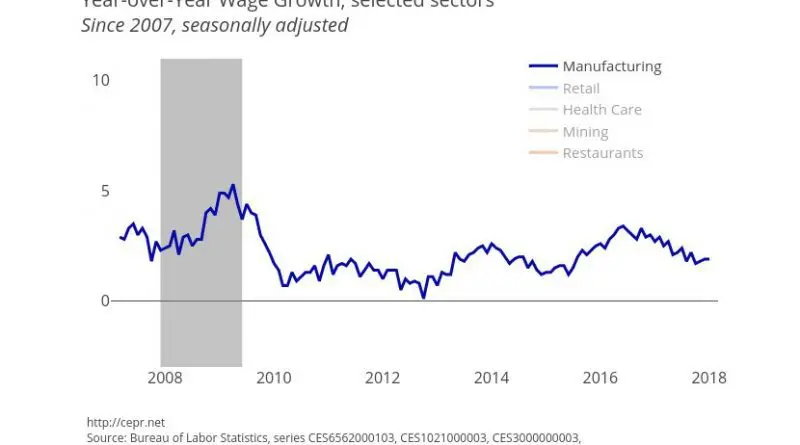US Economy Adds 200,000 Jobs In January, Black Unemployment Jumps 0.9 Percentage Points – Analysis
By Dean Baker
The Bureau of Labor Statistics reported that the economy added 200,000 jobs in January. With modest downward revisions to the prior two months data, this brings average growth over the last three months to 192,000. This is slightly more rapid than the 176,000 average over the last year. The picture on the household side was mixed, with the both the unemployment rate and employment-to-population ratios (EPOPs) remaining unchanged.
However, while the unemployment rate for whites dipped by 0.2 percentage points to 3.5 percent, the black unemployment rate jumped 0.9 percentage points to 7.7 percent, putting it just a hair under the 7.8 percent rate of January, 2017. This was associated with a 0.6 percentage point drop in the employment rate.
This is disappointing since the 6.8 percent rate in December was the lowest on record. (The data only go back to 1972.) The increase for men was 0.9 percentage points to 7.5 percent. For women, the increase was 0.8 percentage points to 6.6 percent, and for teens the rise was 1.4 percentage points to 24.3 percent. The employment data for blacks are highly erratic and it is likely that much of this change is driven by measurement error, but it is nonetheless discouraging to see this reported jump.
The percentage of unemployment due to voluntary quits, a measure of people’s confidence in their labor market prospects, was unchanged at 10.9 percent. It stood at over 12.0 percent before the recession and peaked at over 15 percent in 2000.
Less-educated workers continue to be the biggest job gainers. The unemployment rate for workers without high school degrees fell to 5.4 percent. This compares with a pre-recession low of 5.8 percent and a low point of 5.9 percent back in 2000. At 4.5 percent, the unemployment rate for high school grads is still somewhat above its pre-recession low of 4.0 percent and well above the 3.3 percent low reached in 2000. The 2.1 percent unemployment rate for college grads is only slightly higher than the 1.8 percent low hit in 2007, but well above the 1.5 percent low reached in 2000.
The job growth on the establishment side was broadly based. Construction added 36,000 jobs, considerably more rapid than the 19,000 average over the last year. Manufacturing added 15,000 jobs, almost exactly in line with its average since last January. The retail sector added 15,400 jobs in January after shedding 25,660 in December. This might be a seasonal adjustment issue, but the sector is likely to shed jobs at a modest pace. It has lost 36,000 jobs over the last year, a bit more than 0.2 percent of total employment.
Professional and technical services added just 7,500 jobs last month, compared with an average of 14,400 over the last year. Accounting is the surprising source of weakness, losing 10,100 jobs, the fifth consecutive decline. The tax bill should produce an employment turnaround soon. Health care added 20,600, just below its 24,600 average over the last year, and restaurants added 31,100 jobs, somewhat above their 21,300 average over the last year.
One item suggesting slower job growth going forward is a drop in the diffusion indexes, which show the percentage of industries intending to add jobs. The overall index fell from 65.5 to 57.9, while the manufacturing index fell from 60.5 to 53.9.
The story is mixed on the wage side. The overall average hourly wage is up 2.9 percent year-over-year, a modest acceleration from its prior pace. However, the average wage for production and nonsupervisory workers, a group that excludes many higher-paid workers, rose just 2.4 percent over the last year. By industry, the fastest growth appears to be in restaurants, with higher wages driven both by minimum wage increases and a tightening of the labor market. Wage growth in manufacturing, at 1.9 percent, lags the overall average, as does the 2.2 percent growth in retail.
Overall, this is a positive picture of the labor market with the jump in wages being especially good news. However, there are discouraging signs, such as the drop in the diffusion indexes, the small percentage of unemployment due to voluntary quits, and of course, the rise in the black unemployment rate. In addition, there was a 0.2 hour drop in the length of the average workweek. This led to a drop in average weekly pay, despite the higher hourly rate. This is most likely a blip in the data, but one that is worth noting.

